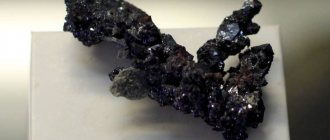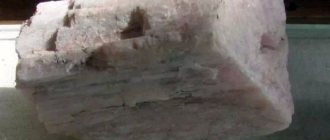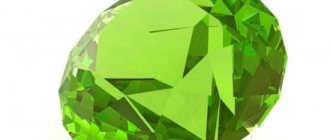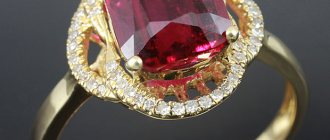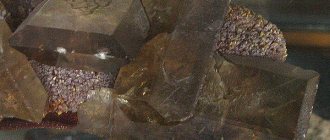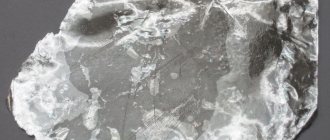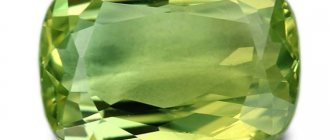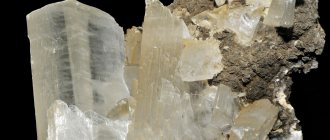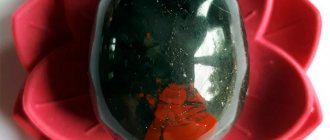The mineral called celestine is made up of strontium sulfate. The Latin term "celestis" translates as "heavenly", that is, the name of this stone indicates its delicate blue color. But there are also blue-gray, yellow and even red celestines. All of them are transparent or translucent and resemble barite in structure. Celestite is distinguished from the last, outwardly very similar mineral by the color of its flame. While calcination of barite in it produces a green tint, celestine in such conditions develops a bright crimson color.
Celestine deposits
Celestine is a common rock with many deposits known on all continents.
Thus, sky-blue crystals are mined on the island of Madagascar, and transparent crystals are mined in Austria. Collectible transparent samples, painted in red-brown tones, are found in the mines of Turkmenistan. In the mountains of Dagestan, rich blue stones are mined. — Advertising —
Celestine is also mined in Italy and the UK, USA and Canada. Large deposits are located in Mexico, China, Iran and Turkey. Suppliers of gem quality stone samples are Germany and Spain. Russian deposits are also known.
Blue Angel
Blue crystals were first mined in Sicily in the 18th century. Celestine mineral is found in cracks and voids in rocks, called geodes. The crystals are shaped like prisms and columns within the rock, and thick plates, crust-like, when found on the surface. They are large - about 50 cm.
Strontium sulfate is found in limestones, dolomites, and gypsum. There are deposits of the celestine mineral in Germany, Canada, Italy (Sicily), Austria (Salzburg), Great Britain, the USA, Russia (Volga region, Southern Urals), Mexico, Madagascar, South Africa, Tajikistan (Shurab), Iran, China, Turkey.
The largest Crystal Cave geode is located near the village of Put-in-Bay in Ohio, USA . It is practically selected and equipped for excursions. But among the crystals remaining here there are giants up to 1 m long.
Sometimes you come across two-color crystals. For example, in Texas, white stones with blue tips are found, and brown ones often have an admixture of yellow or red.
Today, strontium is not mined in Russia, although some deposits are very promising: Mazuevskoye, Tabolsk deposit (Tula region), Blue Stones (Dagestan). There are deposits in the Arkhangelsk region (Pinega river valley), the Volga region (Vodinskoye, with native sulfur), on the Mangyshlak (Ungozya) peninsula, in Buryatia, Tyva, and Yakutia. Since celestite is a sedimentary rock, the mineral is often found on the seabed.
The most beautiful specimens are found in China in the Yangtze River valley, in the Three Gorges area. Legend says that once there was a piece of heaven on Earth with luxurious greenery and a clear river. But twelve demons came and destroyed the paradise, tore out the trees, threw them into the river along with stones. The Three Gorges turned into a desert and people had to leave. Fortunately, the seventh daughter of the heavenly empress found out about this. She called upon the heavenly powers for help and declared war on the demons. For seven days and nights she threw lightning at her insidious enemies until she destroyed everyone, but the Three Gorges turned into a piece of bare, melted earth. To restore its former beauty, the Virgin scattered heavenly seeds on the ashes, which instantly turned into beautiful stone flowers, and the hard worker wind applied a new layer of fertile soil. Soon the Three Gorges turned green.
The first mention in print can be dated back to 1778. In the book “The Moral Justification of Card Games; an interesting and informative story told by a man named Louis Bras-de-Fer, who served the king” there is information about strontium sulfate.
The Germans have an interesting story about how they discovered the celestine deposit.
A German migrant living in the USA, Herr Heinemann, decided to expand his winery and ordered a well to be dug. During the work, they discovered a cave, the walls of which were strewn with protruding bluish-white crystals. “I have found a treasure trove of trolls,” Heinemann thought, but then realized that German trolls do not live in America. Experts determined that it was a huge celestine geode.
History of celestine
The first Celestines were discovered in the 18th century on the island of Sicily, and they were initially called “Sicilianites.”
But later this name was considered dissonant, and at the suggestion of the German scientist Abraham Werner, the stone was renamed “celestine.” This term is of Latin origin and goes back to the word “caelestis”, which translates as “heavenly” and refers to the characteristic blue color of the gem. The samples discovered in Sicily had a somewhat blurred blue color, but it turned out that celestine crystals of other colors are also found in nature.
However, the second name for the mineral has been preserved and entrenched in modern mineralogy.
Form of being in nature
The appearance of crystals . Rhombic crystals are tabular, disk-like, pyramidal. The crystals found are very similar to barite crystals. They usually have a columnar or prismatic appearance, often exhibit blockiness and are prone to splitting.
Doubles on {210} and {101} are very rare.
Aggregates. Mostly granular, fibrous, dense, lamellar, earthy, less often columnar or radial aggregates that fill cracks, veiny and shell-like. It occurs in the form of secretions, and druses of crystals are observed in the voids.
Physico-chemical characteristics of celestine
Celestine consists of strontium sulfate.
Its crystals have a monoclinic system, perfect cleavage, irregular fracture, glassy or pearlescent luster. Pure strontium sulfate is colorless, but impurities can give it a wide variety of shades. — Advertising —
The hardness of the mineral is 2 on the Mohs scale. Density is 2.3-2.4 g/cm3. Brittle, soluble in water, prone to fading in the sun.
When the mineral is added to the flame, it turns reddish. If celestine contains impurities, fluorescence may appear in the ultraviolet spectrum.
In natural geodes, celestite forms large (tens of kilograms) crystals and druses of large volumes.
Chemical composition
Strontium oxide (SrO) 56.42%, sulfur oxide (SO3) 43.58%. Sometimes contains Ca and Ba (often in significant quantities).
Forms an isomorphic series with barite. Intermediate members: barytocelestine, celestobarite. Sr is partially replaced by Ca (calciocelestine).
Varieties
Baritocelestine contains up to 26% BaO; calciocelestine contains a small amount of calcium, which replaces strontium.
Crystallographic characteristics
system .
Symmetry class . Rhombo-bipyramidal. V. With. V. With. 3L23PC. Space group Pnma (D162h). a0 = 8.36; b0 = 5.36; с0 = 6.84. Axle ratio. 1.561 : 1 : 1.276, Z = 4.
The magical properties of celestine
Celestine is a positive and benevolent mineral that has a beneficial effect on a person’s mood.
It is used during meditation. Celestine will give the male owner self-confidence, and the woman - a sense of her own charm and attractiveness. Amulets with celestines also help women cope more easily with personal dramas, separation from a loved one, and gives strength during difficult periods in life. Talismans with this gem are also recommended for overly suspicious and emotional people; they will help them to be calm in difficult situations, to think clearly when necessary, to make quick and correct decisions. Celestine is also considered a stone for talented people. He awakens hidden possibilities and potentials in them, imparts eloquence, and eliminates the fear of speaking in front of a large audience. For maximum effect in this direction, it is important to contact the stone every day.
The healing properties of celestine
To date, lithotherapy has studied little of the healing properties of celestine.
It is known to normalize blood pressure, improve blood circulation and permeability of vascular walls, and relieve rheumatic pain. Celestine is also used in the treatment of eye diseases; the mineral is also used to restore vision. As for the nootropic effect of celestine, the mineral is used carefully, since it alternates between an increase in mental activity and its inhibition, emotional decline and sleep. In order for the power of the stone to have a positive effect, and for the mineral not to have a negative impact on health and mental state, it is important to find a match between the daily rhythm of the person and the gem.
Security measures
Strontium and its salts have a half-life of about one and a half thousand years. The element and its salts are radioactive. It is important to know that the radiation of an element is not absorbed by its surrounding chemical neighbors in the composition of salts. Small stones, of course, cannot kill immediately, but the gradual accumulation of strontium in the body will make itself felt over time. At first, the patient will not feel any problems or deterioration, since all the negative consequences do not appear immediately. And no one will associate late disorders and ailments with close and constant contact with a mineral of this kind.
Branches of application of celestine
Strontium, the main component of celestine, is used for the pharmaceutical, ceramic, glass and pyrotechnic industries.
In metallurgy, strontium is used to alloy alloys and provide hardness to copper and aluminum, as an anti-corrosion coating in aircraft alloys and for zinc. In the 20th century, strontium was used in the manufacture of sparklers, fireworks and rockets. Now strontium nitrate, which is isolated from celestines, is part of red fireworks. Occasionally, celestine is also used in jewelry, but it is very complex in cutting and processing, and therefore products made from it, as a rule, are single copies.
It is not allowed to treat celestine with X-rays, as this increases the radiation of strontium atoms, which can cause harm to human health.
Origin and location
In siege, rock[: in gypsum, anhydrite, rock and potassium salts, in limestones, dolomites, shales, marls, sandstones. Also in hydrotherms, veins and voids of the main igneous rock Asc. with sulfur, strontianite, etc.
1. Sedimentary
Celestine in more or less significant masses in the form of nodules, nests, and sometimes continuous deposits is found in strata of sedimentary rocks (in dolomites, limestones, gypsum-bearing clays, marls, etc.). Its finds are often confined to certain horizons among these rocks. A well-known celestine deposit of this type is confined to the deposits of the Upper Röth in Dornburg near Jena.
It is deposited directly from seawater or from percolating surface waters, which leaches strontium from sedimentary rocks and then deposits celestite in cracks as fibrous aggregates or well-formed crystals.
The strontium-bearing gypsum-marly red formation is of great importance. The genesis of the deposits is attributed to sedimentation-diagenetic. The shapes of ore deposits are lenses and layers, their length is hundreds of meters and a few kilometers. Celestine is represented by nodules and lens-shaped formations. Mineralization is confined to horizons of lacustrine gypsum clays and marls. As V.V. Burkov emphasizes, the strontium-bearing horizons under consideration are underlain or faciesly replaced by strontium-bearing sulfate-carbonate strata, during the partial erosion of which strontium was extracted for subsequent deposition in lacustrine conditions. The deposits are confined to depressions and syneclises of platforms (Iate in Great Britain, deposits of the Mancha basin in Spain, etc.).
The formation of strontium-bearing sulfate-terrigenous variegated deposits is represented by deposits with sheet deposits and lenses of celestine ores. Celestine forms nodules, geodes, veins, and is scattered in the form of individual grains. The most intense strontium mineralization is developed in the underlying gypsum terrigenous members. Among celestine, both sedimentation-diagenetic and later - catagenetic are distinguished. Deposits of this formation are known in Central Asia. Strontium filtration formation in gypsum-carbonate and sand-carbonate strata is of very great practical importance. The shape of ore bodies is sheet-like, lens-shaped, vein-like. Among the carbonate rocks there are dolomites, marls, and limestones.
It has also been established in marine organisms, in particular in the skeletons of one group of radiolarians. It is sometimes found in ammonite shells and other fossils as a result of later deposition in them.
2. Hydrothermal
True, very rare but typical hydrothermal celestine veins containing galena, sphalerite and other sulfides are known.
The formation of strontium-containing polymetallic ores of hydrothermal origin is relatively common, although its industrial significance is small. Celestine and strontianite are obtained mainly as a by-product, although in some places strontium minerals are of leading importance in the deposits and sometimes form independent celestine deposits. It is known, for example, that the Providencia gold-silver-lead deposit (Mexico) has an increased mass fraction of celestine in the ore veins. Hydrothermal strontium-base metal mineralization is established in the Tunguska syneclise (Russia) and is associated with trap magmatism. The shape of ore bodies is complex lenses and rods. Strontium minerals are celestine and celestinobarite. The formation of strontium-bearing fluorite hydrothermal deposits is relatively widely developed, but its industrial significance is small. It is known, for example, a deposit on the river. North Thompson (Canada), in which the mass fraction of celestine in the ore reaches 22%.
3. Igneous
It was also observed in tonsils of igneous rocks.
How to care for celestine
Celestine is a very soft and fragile stone; it is stored separately from other stones and protected from mechanical damage, shock, scratches and chips. For jewelry, velvet bags or boxes with soft walls are suitable. If the product needs to be cleaned, use a damp soft cloth. It is not recommended to dry celestine in the open sun, as well as to expose it to prolonged exposure to direct sunlight. In bright light and high humidity, the mineral quickly loses its qualities.
Celestine and the zodiac sign
The real favorites of celestine in the zodiac are Gemini. As for representatives of other zodiac signs, the exact influence of the stone on them is currently unknown. Celestine helps all people of creative professions, without exception, including writers, artists, constructors, designers and architects, regardless of zodiac affiliation.
Prices for celestine products
Facet-cut celestine is expensive on the jewelry market because it is rare. Collectible specimens of this stone are more common. For example, the cost of a high-quality druse weighing 70 grams, set in silver, is $500-700. The ball, carved from celestine, weighs about 2 kg, is valued at $200. But a bracelet made of large beads of opaque celestine is inexpensive: 8-10 dollars.
Celestine interior decorations are very popular today. In this regard, the “chrysanthemum stone”, which is a small but beautiful cluster of celestines, is in demand. Rosettes made of sparkling white crystals look great against a background of black granite or slate.
Prices
Celestine in silver
You can rarely find jewelry with this stone on the stone market. Most often, collectible crystals or interior items are sold. The average price for products with stone varies within the following limits:
- up to $700 - for a processed crystal in silver weighing up to 100 g;
- $200-300 - for a souvenir ball weighing up to 2 kg;
- $10-20 for a celestite bracelet;
- $50-100 – for a raw celestine crystal weighing up to 500 g.
Interesting facts about celestine:
- In the state of Ohio in the USA, there is the largest celestine geode (“Crystal Cave”), which reaches a diameter of 10 m. Now it has been equipped as an object for tourists to visit, and among the celestine crystals there are samples about 1 m long.
- According to the Chinese legend about the origin of celestine, demons who hated beauty once settled in one of the most beautiful places on our planet. They filled everything around them with liquid mud. But the heavenly forces burned the demons, and the soil at the site of the fire petrified, and seeds fell from heaven onto the damaged earth, which became sprouts in the thickness of the fossils. It is these sprouts that are celestines.
- In Europe, celestines were associated with a different story. The name Celestine in the Middle Ages was the personification of light, purity and infallibility, as it was borne by a Benedictine monk who lived in the 13th century, led a hermit life and was elected pope, but renounced his high rank. It is believed that a stone rosette of the mineral celestine, similar to a chrysanthemum, can reveal its beauty only to a righteous saint.
What's in your hands?
In Italy, Celestine is a common name; it was taken by the Benedictine monk Pietro Angelari del Murrone, who founded the order of Celestine hermits, when taking the rank of pontiff. He became pope at the age of eighty, but resigned five months later because he could not stand in the “sacred den” that was the Catholic Church of the 13th century.
Hobbyists (by the way, stone collectors have not yet come up with a decent name) often confuse celestite with calcite, dolomite and barite. But calcite is not blue, but colorless, barite is heavy, and dolomite has a completely different crystal shape.
To finally make sure that you have celestite, heat the mineral - it will turn red. But if you are sure that you are holding celestine in your hands, it is better not to heat it. Other names are holy celestine, celestite, celestel.
